Related Research Articles

An ice shelf is a large floating platform of ice that forms where a glacier or ice sheet flows down to a coastline and onto the ocean surface. Ice shelves are found in Antarctica and the Arctic. The boundary between the floating ice shelf and the anchor ice that feeds it is the grounding line. The thickness of ice shelves can range from about 100 m (330 ft) to 1,000 m (3,300 ft). The world's largest ice shelves are the Ross Ice Shelf and the Filchner-Ronne Ice Shelf in Antarctica. When a large piece of an ice shelf breaks off, this can lead to the formation of an iceberg. This process is also called ice calving.

In glaciology, an ice sheet, also known as a continental glacier, is a mass of glacial ice that covers surrounding terrain and is greater than 50,000 km2 (19,000 sq mi). The only current ice sheets are the Antarctic ice sheet and the Greenland ice sheet. Ice sheets are bigger than ice shelves or alpine glaciers. Masses of ice covering less than 50,000 km2 are termed an ice cap. An ice cap will typically feed a series of glaciers around its periphery.
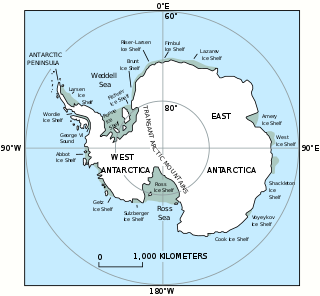
The Western Antarctic Ice Sheet (WAIS) is the segment of the continental ice sheet that covers West Antarctica, the portion of Antarctica on the side of the Transantarctic Mountains that lies in the Western Hemisphere. It is classified as a marine-based ice sheet, meaning that its bed lies well below sea level and its edges flow into floating ice shelves. The WAIS is bounded by the Ross Ice Shelf, the Ronne Ice Shelf, and outlet glaciers that drain into the Amundsen Sea.

The Antarctic ice sheet is one of two ice sheets on Earth and covers about 98% of the Antarctic continent. It is the largest single mass of ice on Earth, with an average thickness of over 2 kilometres (1.2 mi). It is distinct from the Antarctic sea ice. The Antarctic ice sheet covers an area of almost 14 million square kilometres and contains 26.5 million cubic kilometres of ice. The other ice sheet on Earth is the Greenland ice sheet.

A Heinrich event is a natural phenomenon in which large groups of icebergs break off from the Laurentide Ice Sheet and traverse the Hudson Strait into the North Atlantic. First described by marine geologist Hartmut Heinrich, they occurred during five of the last seven glacial periods over the past 640,000 years. Heinrich events are particularly well documented for the last glacial period but notably absent from the penultimate glaciation. The icebergs contained rock mass that had been eroded by the glaciers, and as they melted, this material was dropped to the sea floor as ice rafted debris forming deposits called Heinrich layers.
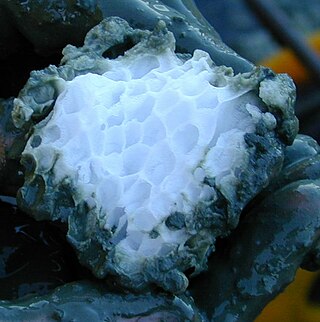
An abrupt climate change occurs when the climate system is forced to transition at a rate that is determined by the climate system energy-balance. The transition rate is more rapid than the rate of change of the external forcing, though it may include sudden forcing events such as meteorite impacts. Abrupt climate change therefore is a variation beyond the variability of a climate. Past events include the end of the Carboniferous Rainforest Collapse, Younger Dryas, Dansgaard–Oeschger events, Heinrich events and possibly also the Paleocene–Eocene Thermal Maximum. The term is also used within the context of climate change to describe sudden climate change that is detectable over the time-scale of a human lifetime, possibly as the result of feedback loops within the climate system or tipping points.

Thwaites Glacier is an unusually broad and vast Antarctic glacier located east of Mount Murphy, on the Walgreen Coast of Marie Byrd Land. It was initially sighted by polar researchers in 1940, mapped in 1959–1966 and officially named in 1967, after the late American glaciologist Fredrik T. Thwaites. The glacier flows into Pine Island Bay, part of the Amundsen Sea, at surface speeds which exceed 2 kilometres (1.2 mi) per year near its grounding line. Its fastest-flowing grounded ice is centered between 50 and 100 kilometres east of Mount Murphy. Like many other parts of the cryosphere, it has been adversely affected by climate change, and provides one of the more notable examples of the retreat of glaciers since 1850.

The East Antarctic Ice Sheet (EAIS) is one of two large ice sheets in Antarctica, and the largest on the entire planet. The EAIS lies between 45° west and 168° east longitudinally.

In climate science, a tipping point is a critical threshold that, when crossed, leads to large, accelerating and often irreversible changes in the climate system. If tipping points are crossed, they are likely to have severe impacts on human society and may accelerate global warming.

Antarctica is Earth's southernmost and least-populated continent. Situated almost entirely south of the Antarctic Circle and surrounded by the Southern Ocean, it contains the geographic South Pole. Antarctica is the fifth-largest continent, being about 40% larger than Europe, and has an area of 14,200,000 km2 (5,500,000 sq mi). Most of Antarctica is covered by the Antarctic ice sheet, with an average thickness of 1.9 km (1.2 mi).
The Karl-Scheel-Preis is an award given annually by the Physikalische Gesellschaft zu Berlin, a regional association of the Deutsche Physikalische Gesellschaft, for outstanding scientific work. The prize was established through an endowment by the German physicist Karl Scheel and his wife Melida. Recipients are awarded with the Karl-Scheel Medal and 5.000 Euros. The Karl-Scheel Medal in bronze was designed by the German sculptor Richard Scheibe and has a diameter of 12 cm.
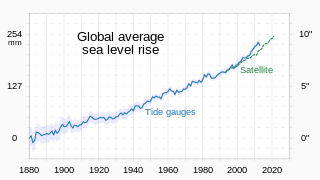
Between 1901 and 2018, the average global sea level rose by 15–25 cm (6–10 in), or an average of 1–2 mm per year. This rate accelerated to 4.62 mm/yr for the decade 2013–2022. Climate change due to human activities is the main cause. Between 1993 and 2018, thermal expansion of water accounted for 42% of sea level rise. Melting temperate glaciers accounted for 21%, with Greenland accounting for 15% and Antarctica 8%. Sea level rise lags changes in the Earth's temperature. So sea level rise will continue to accelerate between now and 2050 in response to warming that is already happening. What happens after that will depend on what happens with human greenhouse gas emissions. Sea level rise may slow down between 2050 and 2100 if there are deep cuts in emissions. It could then reach a little over 30 cm (1 ft) from now by 2100. With high emissions it may accelerate. It could rise by 1 m or even 2 m by then. In the long run, sea level rise would amount to 2–3 m (7–10 ft) over the next 2000 years if warming amounts to 1.5 °C (2.7 °F). It would be 19–22 metres (62–72 ft) if warming peaks at 5 °C (9.0 °F).
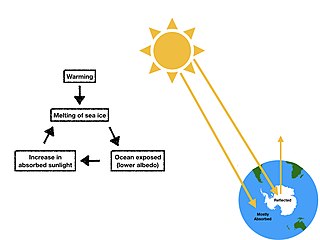
Ice–albedo feedback is a positive feedback climate process where a change in the area of ice caps, glaciers, and sea ice alters the albedo and surface temperature of a planet. Ice is very reflective, therefore it reflects far more solar energy back to space than the other types of land area or open water. Ice–albedo feedback plays an important role in global climate change. For instance, at higher latitudes, warmer temperatures melt the ice sheets. However, if warm temperatures decrease the ice cover and the area is replaced by water or land, the albedo would decrease. This increases the amount of solar energy absorbed, leading to more warming. The change in albedo acts to reinforce the initial alteration in ice area leading to more warming. Warming tends to decrease ice cover and hence decrease the albedo, increasing the amount of solar energy absorbed and leading to more warming. In the geologically recent past, the ice–albedo positive feedback has played a major role in the advances and retreats of the Pleistocene ice sheets. Inversely, cooler temperatures increase ice, which increases albedo, leading to more cooling.
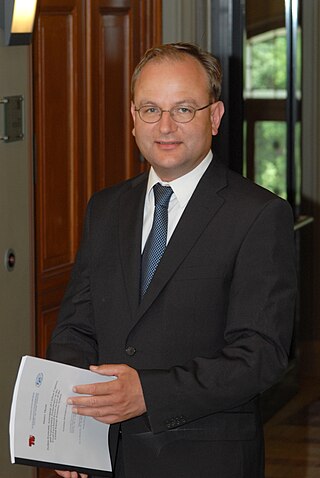
Ottmar Georg Edenhofer is a German economist who is regarded as one of the world's leading experts on climate change policy, environmental and energy policy, and energy economics. His work has been heavily cited. Edenhofer currently holds the professorship of the Economics of Climate Change at the Technical University of Berlin. Together with Earth scientist Johan Rockström, economist Ottmar Edenhofer is scientific director of the Potsdam Institute for Climate Impact Research (PIK), representing the interdisciplinary and solutions-oriented approach of the institute. Furthermore, he is director of the Mercator Research Institute on Global Commons and Climate Change (MCC). From 2008 to 2015 he served as one of the co-chairs of the Intergovernmental Panel on Climate Change (IPCC) Working Group III "Mitigation of Climate Change".

Anders Levermann is a climate scientist at the Potsdam Institute for Climate Impact Research and Columbia University. He is a Professor of the Dynamics of the Climate System at Institute for Physics and Astrophysics of the Potsdam University, Germany. He has been involved in the assessment report of the Intergovernmental Panel on Climate Change since 2004. Levermann advises political and economic stakeholders on the issue of climate change.
The Wilkes Basin is a large subglacial basin situated generally southward of George V Coast and westward of Prince Albert Mountains in East Antarctica. The feature is approximately 1400 km long and 400 km wide. The Wilkes Basin is considered to be the largest marine-based drainage basin in East Antarctica, and may be in a state of marine ice sheet instability, caused by warm water intrusion into the shelf cavities.
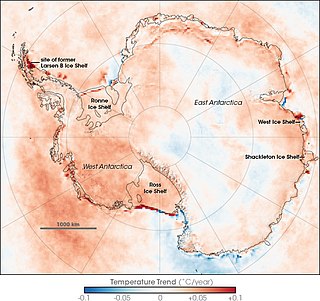
Temperature change due to climate change in Antarctica is not stable over the whole continent. West Antarctica is warming rapidly, while the inland regions are cooled by the winds in Antarctica. Water in the West Antarctic has warmed by 1 °C since year 1955. Further increase in temperature in water and on land will affect the climate, ice mass and life on the continent and have global implications. Present-day greenhouse gas concentrations are higher than ever according to ice cores from Antarctica, which indicates that warming on this continent is not part of a natural cycle and attributable to anthropogenic climate change.
The Ice Sheet Mass Balance Inter-comparison Exercise (IMBIE) is an international scientific collaboration attempting to improve estimates of the Antarctic and Greenland ice sheet contribution to sea level rise and to publish data and analyses concerning these subjects. IMBIE was founded in 2011 and is a collaboration between the European Space Agency (ESA) and the National Aeronautics and Space Administration (NASA) of the United States, and contributes to assessment reports of the Intergovernmental Panel on Climate Change (IPCC). IMBIE has led to improved confidence in the measurement of ice sheet mass balance and the associated global sea-level contribution. The improvements were achieved through combination of ice sheet imbalance estimates developed from the independent satellite techniques of altimetry, gravimetry and the input-output method. Going forwards, IMBIE provides a framework for assessing ice sheet mass balance, and has an explicit aim to widen participation to enable the entire scientific community to become involved.
Sophie Marie Jeanne Nowicki, is Empire Innovation Professor in the Department of Geology of the University at Buffalo. She does research on the Greenland and Antarctic ice sheets, focusing on their connections to global climate and sea level. Before that, she was physical scientist at the Nasa Goddard Space Flight Centre, investigating ice sheet changes.
Sarah Das is an American glaciologist and climate scientist. She works at the Woods Hole Oceanographic Institute in Woods Hole, Massachusetts.
References
- ↑ ""Sie hat eine ungeheure Neugier"". Der Tagesspiegel Online (in German). Retrieved 2022-04-07.
- 1 2 Ronja Kolls (17 Sep 2020). "Ricarda Winkelman profile". Tagesspiegel.
- ↑ "Ricarda Winkelmann wird Gründungsdirektorin am MPI für Geoanthropologie". Max Planck Society. Retrieved 30 October 2023.
- 1 2 3 4 "Physical Society of Berlin honors Ricarda Winkelmann — Potsdam Institute for Climate Impact Research". www.pik-potsdam.de. Retrieved 2022-04-07.
- ↑ Authors, The PISM. "PISM". PISM. Retrieved 2022-04-13.
- ↑ "Universität Potsdam - Institut für Physik und Astronomie". www.physik.uni-potsdam.de. Retrieved 2022-04-13.
- ↑ "EGU Early Career Award for Ricarda Winkelmann — Potsdam Institute for Climate Impact Research". www.pik-potsdam.de. Retrieved 2022-04-07.
- ↑ von Mirbach, Johan (15 Sep 2015). "Worst-case scenario for sea level rise: No more New York, Berlin or Shanghai | DW | 15.09.2015". DW.COM. Retrieved 2022-04-07.
- ↑ Garbe, Julius; Albrecht, Torsten; Levermann, Anders; Donges, Jonathan F.; Winkelmann, Ricarda (Sep 2020). "The hysteresis of the Antarctic Ice Sheet". Nature. 585 (7826): 538–544. Bibcode:2020Natur.585..538G. doi:10.1038/s41586-020-2727-5. ISSN 1476-4687. PMID 32968257. S2CID 221885420.
- ↑ Edwards, Tamsin L.; Nowicki, Sophie; Marzeion, Ben; Hock, Regine; Goelzer, Heiko; Seroussi, Hélène; Jourdain, Nicolas C.; Slater, Donald A.; Turner, Fiona E.; Smith, Christopher J.; McKenna, Christine M. (May 2021). "Projected land ice contributions to twenty-first-century sea level rise". Nature. 593 (7857): 74–82. Bibcode:2021Natur.593...74E. doi:10.1038/s41586-021-03302-y. hdl: 10023/24263 . ISSN 1476-4687. PMID 33953415. S2CID 233871029.